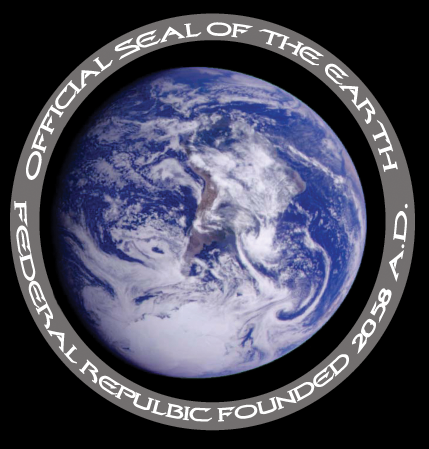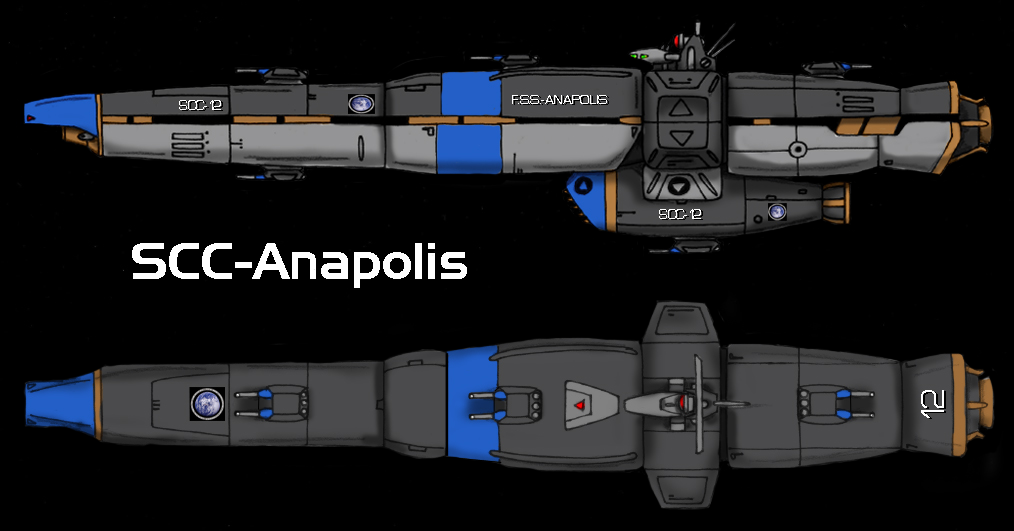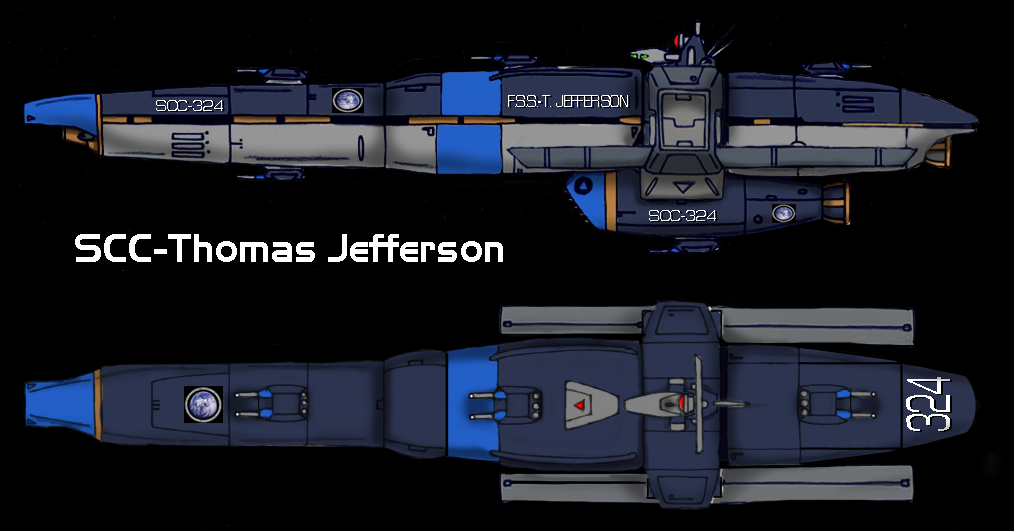 |
 |
|

GOVERNMENT: Earth Federal Republic
TYPE: Space Cruiser (SCC)
MODELS:
Anapolis class
Thomas Jefferson class
DATE INTRODUCED:
2068 AD (Anapolis)
2075 AD (Thomas Jefferson)
LENGTH: 610 feet
WIDTH: 90 feet
HEIGHT: 86.7 feet
MATERIAL:
Composite-Alloy (Anapolis class)
Crystal Composite (Thomas Jefferson class)
POWER PLANT:
Rockwheel Energy RFR-50M fusion reactor (Anapolis class)
2x Federal Energy FEFR-60M fusion reactor (Thomas Jefferson class)
OUTPUT:
20,000 megawatts (RFR-50M)
2x 60,000 megawatts (FEFR-60M)
ARMOR TYPE:
Composite-Alloy (Anapolis class)
Crystal Composite (Thomas Jefferson class)
ARMOR THICKNESS:
.465 inches (Anapolis class)
.465 inches (Thomas Jefferson class)
DISPLACEMENT: 6000 tons
CREW: 79 plus up to 20 flight, for 99 total. (10 Operators, 28 Gunners, 7 Officers, 10 Engineers, 10 Technicians, 10 Electricians, 4 Medical, and up to 20 spacefighter pilots)

PROPULSION:
(Anapolis class)
PRIMARY (Main Engines):
4x Rocketdyne FT-2000 fusion thrusters
SPEED: 30,400 mph each (121,600 mph total)
(Thomas Jefferson class)
PRIMARY (Main Engines):
4x Lunar Dynamics PD-20M plasma drives
SPEED: kiloMACH 40 each (30,400,000 mph or .045C each, or .18C total)
WEAPONS:
(Anapolis class)
HEAVY ASSAULT
1x MMI EMPAC-5M 5000-megawatt electromagnetic particle accelerator cannon; Effective Range: 25,000 miles; Payload: unlimited with nuclear battery clutch system; ROF: fires one blast per ten seconds, however, the weapon requires 50 seconds to completely cool off after each shot so as not to overheat/melt the unit. Therefore, the EMPAC weapon's effective/safe ROF is once per minute.
PRIMARY (OFFENSIVE):
5x Lunar Dynamics LD-LC-600 dual 300-megawatt laser cannon turrets; Effective Range: 3000 miles; Payload: unlimited with nuclear battery clutch system; ROF: fires one dual blast per ten seconds with a cyclic rate of 6 dual blasts per minute.
SECONDARY (OFFENSIVE):
10x Bohing/MMI STL-02 space torpedo tubes; Missile Type: MHST-01 2000-pound SMART-guided space torpedo; Effective Range: 27 miles; Payload: 10 space torpedoes each in an autoloading torpedo tube; ROF: 1 torpedo per two seconds with a cyclic rate of 30 torpedoes per minute.
(Thomas Jefferson class)
HEAVY ASSAULT
1x MMI EMPAC-10M 10,000-megawatt electromagnetic particle accelerator cannon; Effective Range: 25,000 miles; Payload: unlimited with nuclear battery clutch system; ROF: fires one blast per ten seconds, however the weapon requires 20 seconds to completely cool off after each shot so as not to overheat/melt the unit. Therefore, the EMPAC weapon's effective/safe ROF is twice per minute.
PRIMARY (OFFENSIVE):
5x Federal Armory FA-LC-690 dual 345-megawatt laser cannon turrets; Effective Range: 3450 miles; Payload: unlimited nuclear battery clutch; ROF: 3 dual blasts every twenty seconds with a cyclic rate of 9 dual blasts per minute.
SECONDARY (OFFENSIVE):
10x Republic Arms RA-STL-02A1 space torpedo tubes; Missile Type: MST-1M 1000-pound Active EMS-guided space torpedo; Effective Range: 7111 miles; Payload: 20 space torpedoes each in an autoloading torpedo tube; ROF: 1 torpedo per two seconds with a cyclic rate of 30 torpedoes per minute.
ELECTRONICS:
(Anapolis class)
1x Laser Communications array with a 1000 AU range.
1x Passive EMS sensor array with a range of 500,000 miles.
1x Active EMS sensor array with a range of 50,000 miles.
1x Gravitational Control/Antigravity unit Effect: provides artificial lift,g-force compensation and enhanced maneuverability.
(Thomas Jefferson class)
1x Laser Communications array with a 1000 AU range.
1x Passive EMS sensor array with a range of 1,000,000 miles.
1x Active EMS sensor array with a range of 100,000 miles.
1x Gravitational Control/Antigravity unit Effect: provides artificial lift,g-force compensation and enhanced maneuverability.
DEFENSE SYSTEMS:
(Anapolis class)
6x MMI ND-1M 1000-megawatt nuclear dampener generators; RANGE: 100 miles; Effect: Random due to numerous variables. In general, the nuclear dampeners provided moderate to considerable resistance to energy weapons and was able to cause missile warheads to either explode or go inert within its area of effect.
(Thomas Jefferson class)
6x Warptron DF-1M 1000-megawatt deflector field generators; RANGE: 1000 feet; OUTPUT: 50 gigajoules with a regeneration rate of 5 gigajoules per ten seconds.
HANGAR BAYS:
(Anapolis class)
1x 5660-yd3; Bay holds up to twenty 50-ton HSF-01 spacefighters and 1660 yd3 of ordinance for the fighters.
(Thomas Jefferson class)
1x 4643.8-yd3; Bay holds twenty 30-ton SBR-01A1 or SBR-0R space battlerobots plus 2243.8 yd3 of ordinance for the battlerobots.
Description/Overview:
(ALL MODELS)
The Anapolis class family of main space cruisers was the primary capital ship of the Earth Federal Republic throughout the 1st Interplanetary War. The first two models (Anapolis and T. Jefferson classes) were built as both squadron command ships and main combat vessels. They were moderately inexpensive and easily mass produced. These craft were very capable as space warships, but only moderately capable in an atmosphere. Throughout their career in military service, the Anapolis class family of main space cruisers were normally used as command ships and thus were commonly found in command of two Colorado class destroyers (or upgrade) and four Arctic class escorts (or upgrade) at any given time. This constituted a light-battlegroup in the Earth Federal SpaceNavy forces.
(Anapolis class)
Named after the EFR's Brazillian Space Warfare Coordination Center in South America, The Anapolis class main space cruiser was built by the Earth Federal Republic in 2068 AD and originally designated as a battlecruiser. However, when the USSN merged with the Earth Federal Republic, the ship was reclassified as a main space cruiser. This was due to the EFR having recovered the alien battleship in the Ross Sea. The alien ship was a 500,000-ton warship. From the information discovered on this alien battleship, it was determined that the alien main space cruiser was somewhere between 10,000 and 50,000 tons displacement. Since the UN had access to these craft, the EFR intended to build craft that could equal the alien ships. Fortunately for the crews of the Anapolis class main space cruisers, they never faced any alien craft during their years of service.
The Anapolis class was a pure space warship capable of taking on anything the UNSC possessed during the 1st Interplanetary War. This measure of supeiroirity was due in part to the hangar bay that was originally designed to accommodate the HSF-01 heavy spacefighter for use in defense of the Anapolis class cruiser against other mobile weapons.
Propulsion for the warship was provided by four Rocketdyne FT-2000 fusion thrusters. These engines were capable of moving the ship within the inner sphere of the Sol star system adequately.
The ship's modest power requirements were fed by one Rockwell RFR-50M, 50,000 MW, fusion reactor.
This class of vessel was the first Earth produced spaceship to mount a maw gun. This weapon was designed to destroy or severely damage another spacecraft with one shot. The weapon chosen for this role was the Militia Military Industries EMPAC-5M, electromagnetic particle accelerator cannon. The EMPAC-5M was capable of destroying any UN assault shuttle with one hit and inflicting serious damage to most of the Solar Empire "Ironclad" types of improved space warships of the 1st Interplanetary War era.
The primary weapons used by the Anapolis were its five turrets, each equiped with a Lunar Dynamics LD-LC-600, dual 300 megawatt, laser cannon battery. These weapons were useful against other warships, but not as good against spacefighters and battlerobots. The small mobile weapons were just too nimble for the large turrets to hit effectively.
The main anti-ship weapons of the Anapolis were ten Bohing/MMI STL-02, space torpedo launchers. These launchers fired the SST-1M, 1000 lb short range space torpedo which was the standard EFF torpedo of the early years of the 1st Interplanetary War.
The Anapolis was equipped with six MMI ND-1M, 1000 MW nuclear dampners as its main defense systems. These deflector screen generators were effective against all UNSC weapons and all but the largest armaments of the Solar Empire's "Ironclad" fleet.
(Thomas Jefferson class)
The Thomas Jefferson class was a part of the EFR upgrade program. This class was simply a refit of the Anapolis with the new plasma drives, deflector field generators, and other systems. The reason for this upgrade was due to the introduction of improved space warships into the Solar Empire fleet. In addition, the rise of the Union of Solar Republics, Ceres Regency, and possible secession of General Walsh's EFSM was on the backs of the minds of most of the
EFSN military leaders. The introduction of the space battlerobot (SBR-01) was critical in the upgrade of the Anapolis to the T. Jefferson. The hangar bay was redesigned to accommodate the new machine.
In order for the T. Jefferson class of ships to travel throughout the inner sphere of the Solar System more quickly, the old fusion thrusters were replaced with four Lunar Dynamics PD-20M, 20,000-megawatt plasma drives. These drives were capable of propelling the vessel at speeds of .04C each (kiloMach 40 or 4% the speed of light), and had a combined speed of .16C (kiloMach 160 or 16% the speed of light). This meant that the Thomas Jefferson class could reach Mars in as little as four hours, or Jupiter in a few days. It gave the EFSN a much-needed boost to their rapidly disintegrating control of the inner sphere of the Sol System.
The power requirement of the ship was quite large for a vessel of only 10,000 tons displacement. Thus, two Federal Energy FEFR-60M, 60,000 MW, fusion reactors were installed on the spacecraft due to the massive energy requirements of the plasma drives.
Like the Anapolis before it, the Thomas Jefferson class was armed with a maw gun. This time a MMI (Militia Military Industries) EMPAC-10M, 10,000 MW, improved electro-magnetic particle accelerator cannon was used. The old EMPAC was no longer able to inflict the kind of damage needed to destroy Union of Solar Republics or Solar Empire warships. Therefore, the Earth Federal Republic senate demanded the older EMPAC replaced with one that was twice as powerful. The new maw gun was extremely effective against anything the USR or Solar Empire had in their arsenals.
The main energy weapon turrets were upgraded to five Federal Armory FA-LC-690, dual 345 megawatt, laser cannon batteries. These turrets served the same purpose as the original laser cannons did before and suffered from the same flaw of not being useful against small targets like fighters and battlerobots. However, against their intended targets these turrets performed quite well.
The main anti-ship weapons were ten Republic Arms RA-STL-02A1 space torpedo launchers. These launchers fired the MST-1M, 1000 lb medium range space torpedoes. These torpedoes could mount a number of different warhead types ranging from fragmentation (for planetary operations) to nuclear (for heavy assault in space). Overall, the RA-STL-02A1 was a very effective weapon system for its time.
The Thomas Jefferson was equipped with six Warptron DF-1M, 1000 MW, deflector field generators. These deflector fields were adequate against spacefighters and assault shuttles used by the UNSC, but were only moderately effective against the capital ship weapons of the Solar Empire "Ironclads."
Of the 980 Thomas Jefferson class built and the 360 Anapolis class upgraded to T. Jefferson class, only 740 survived the Ceres conflict (500 Thomas Jefferson class and 240 Anapolis upgrades). All of these remaining main space cruisers were upgraded to Benjamin Franklin class ships in 2093 AD.